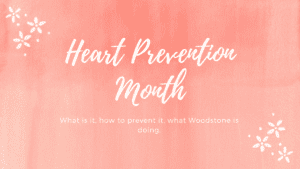Morgan Gulden, RN, Director of Health Services discusses Heart Disease in honor of Heart Disease Prevention Month .
“The month of February is dedicated to spreading awareness to the number one leading cause of death in the United States.”
What is Heart Disease?
Heart disease is a broad category that includes several types of heart conditions. The most common type of heart disease in the United States is called coronary artery disease, which affects the blood flow to the heart. This disease can ultimately lead to a heart attack. Knowing how to prevent heart disease is a crucial concept to understand. There are two sides of risk factors when it comes to diseases; ones that can be controlled and ones that cannot. Let’s dive into the differences and what you can do to make the right choices for your body!
Unfortunately, there are aspects of life that we cannot control to help better our health, these are called uncontrolled risk factors. Examples of uncontrolled risk factors are age, sex, race, and family history. The risk for heart disease increases as a person’s age gets higher. The greatest risk starts when men reach 45 and when women reach 55. Risks may affect women differently over men as well; depending on circumstances. When talking about race it has shown that African Americans, Caucasians, and South Asians are the most common races to have heart disease, while Hispanic Americans and East Asians are less likely to have it. Lastly, a family history of heart disease creates a greater risk for those who have close family members who developed heart disease at an early age.
How to Better Your Health…
 It may seem overwhelming after hearing those risk factors, but there are many steps that you can take to better your health to decrease your chances of developing heart disease. Starting with blood pressure control. Having increased blood pressure (known as hypertension) is a major risk factor. Things to help with controlling blood pressure is to have it checked regularly- it is recommended once a year for the average adult but more often if you have other risk factors. Blood pressure can be controlled with medication if it is prescribed by the doctor. Lifestyle factors that can be controlled include diet, exercise, and smoking cessation.
It may seem overwhelming after hearing those risk factors, but there are many steps that you can take to better your health to decrease your chances of developing heart disease. Starting with blood pressure control. Having increased blood pressure (known as hypertension) is a major risk factor. Things to help with controlling blood pressure is to have it checked regularly- it is recommended once a year for the average adult but more often if you have other risk factors. Blood pressure can be controlled with medication if it is prescribed by the doctor. Lifestyle factors that can be controlled include diet, exercise, and smoking cessation.
Having a heart-healthy diet is crucial for people to obtain. Foods that will increase your risk for heart disease include foods that have high saturated and trans fats, high salt content, and high sugar content. Most processed foods tend to include many of these characteristics. Look for foods that have high fiber content, low saturated and trans fats, and low sodium! Foods to incorporate are fresh fruits and vegetables! Along with a healthy diet, it is important to incorporate an exercise routine for your health! The CDC recommends 2 hours and 30 minutes of moderate-intensity exercise a week. This would include brisk walking or riding. Managing stress, limiting alcohol, and not smoking are other ways to help reduce the risk!
What Are We Doing at Woodstone?
This week at Woodstone, we are focusing on different areas of heart health.
- We are eating healthy snacks and exercising regularly.
- Woodstone put on a presentation about unhealthy vs healthy foods.
- We discussed stress management: stress balls, encouraging breaks and healthy coping mechanisms.
Knowing if you have risks for heart disease is very important for you to figure out! Once you figure them out, it will be helpful to look at what you can change in your lifestyle to better your health! Check out the American Heart Association website for more information on heart disease and prevention!
Information from:
https://medlineplus.gov/howtopreventheartdisease.html, CDC, and American Heart Association
Best,
Danielle Morrow
Marketing Specialist



